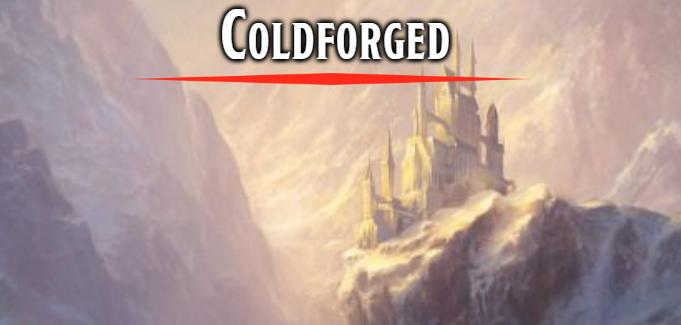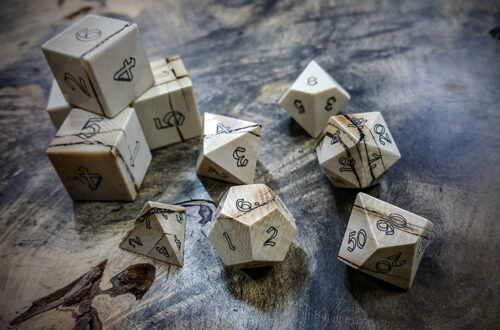
Coldforged: A Brief History of Tysis 9 – The Fourth Age Part 3
Each Thursday this year, I focus on a different aspect of the world I’ve created and played D&D in for over 20 years, in the hopes of honing the ideas and cementing enough in place to settle the world in my own mind. This week I’ll continue to pull all the histories together and work towards the current time, starting at the dawn of the 4th Age, the current time
Brokensail
The city of Brokensail is a recent addition to the political landscape of Tysis, and not a positive one. The remnants of County Jeslith have banded together in a makeshift city, working under the eye of the dragon Jet to secure tribute and protect themselves from further depredations of more powerful kingdoms.
The city of Brokensail is ruled by a council of admirals who hold lose power over their subjects. Each of these Admirals has purchased their seat on the council through donations and tributes to Jet, murder, assassination, or all of the above. These Admirals are unwilling to test the loyalty of their subjects to any given cause or individual and take criminal activity, or anything they deem as criminal activity extremely and brutally serious. They hold themselves to a loose code of conduct among each other, but this does not trickle down to or among the common rabble of the city, whose inhabitants are mainly smallfolk; goblins, gnomes, dwarves and the majority halflings. Collectively, the Council makes decisions on the disposition of raids, individual punishment or rewards, and oversees the fortification, defense, and expansions to the city. This last responsibility is ever more burdensome as the population expands with both refugees and fugitives from across the continent.
Captains of Brokensail, each beholden to an Admiral, raid towns and villages across southern Tyndaria, Western Killbar, and Northwestern Lev, and they also engage in ship to ship piracy, granting no kingdoms color immunity. This has given sea commerce, as well as some river trade, a dangerous reputation, something that only the brave or foolhardy partake in unless properly defended.
While the city is one built on piracy and raiding, not everything can be stolen in enough quantity to sustain the population it has. Thankfully, the smallfolk of County Jeslith included many different master craftsmen who either continue to practice to this day or have passed on their skills to their apprentices who now run the shops. These crafters
Amongst the craftsmen of Brokensail are brands of both shipbuilders and smiths that maintain the pinnacle of their crafts. The shipbuilders are adept at the small, maneuverable, light craft that the pirate captains prefer, those that are sized better for their smaller crews. They work closely with their master sailmakers to build the optimal sailing crafts for the wolf pack piracy tactics so often applied by the Brokensail buccaneers.
To arm the ships with appropriate weapons, the smiths and bowyers create weapons that are reliable enough to survive the long weeks in cold, salty waters. They provide sturdy axes, grappling hooks, and gaffs, dependable crossbows both large and small, complex ship-mounted ballista, and marvelous firearms and bombs. This, combined with the discoveries from the Fraternity of Thunder in creating searing sand keep those who don’t actively raid industrious and busy supplying those who do.
The Aldashir Citadel
The Drimmen have suffered intensely in the last decades, having fought and lost a war against the stone and frost giants that ultimately exiled them from their ancestral home in the mountains of Drimm. Those that escaped the Kingdom now have been offered refuge by King Wanderer of Tyndaria at the old Occuran Citadel of Aldashir, an enormous fortress on the banks of the Kyish River in the foothills of Drimm.
The Citadel overlooks the most trafficked path into and out of Drimm, the Brightstone Highway, and it is where the King of Aldashir, Regrik Ironbreaker III, plots his revenge against the giants, whom the Kingdom fled from and who now occupy the holdfasts and halls within the great eastern mountain range.
When the giants and their kin brought war to Drimm, they did so in a surprisingly effective manner, taking the southern holds with surprising ease. Whole populations fled to the remaining northern bastions, flooding the unprepared and unexpected halls with a flood of refugees, which weakened the ability of the next city in the path to whether the inevitable assault. Even after the quiet years and the short truce, the Drimmen were unable to recover enough to last through any sort of hardships, taxing their food stores and manpower to its limits before any giants even stood at the gates.
While turning away the refugees and the weak could possibly have saved Drimm, the leaders of the holds refused, citing ancient texts, strong traditions, and written codes to the few who espoused the reasonable, if harsh, option. Instead, the Drimm stood as one, and fell as one, together.
Some refugees did flee west, to Tyndaria and Killbar, or north to Lev and Thrax. A few sea traders even managed to seek refuge within the city of Brokensail. The vast majority, though, stuck it out to the end, when the last city fell, and the famed Darkthunder Guards stood fast against their opponents, falling to the last to ensure that the refugee train made it out of the mountains alive.
This refugee train made its way into Tyndaria, to the citadel of Aldashir, where a small group of Tyndarians clung to life around the crumbling structure. They were unopposed as they collapsed at the citadel and began building a temporary camp. They were met, Wanderer having been made aware of the plight, buy a small force of Blades, weeks later. The Blades were under the impression that it was a few scattered refugees and were stunned to see hundreds of Drimm in a makeshift city, huddling in the slowly cooling fall weather. The Drimmen emissaries claimed the citadel, reciting a portion of a treaty long forgotten by the Tyndarians regarding mutual defense, safe harborage, and the succor in time of need. The stunned Blades returned to the Tyndarian capital, where Wanderer, busy with a half dozen border wars and rebellions, agreed with the Drimm in order to prevent opening another war front.
To this day, the Drimmen hold Aldashir Citadel, and have built a fairly large city outside its grounds. Sitting high on a crag above the Brightstone, it is in a fortified and defensive position, and with the newly built walls encircling the town, the Drimm and those who have stayed or moved into the city of Aldashir now find themselves in a safe position.
The King of Aldashir Citadel is now Regrik Ironbreaker III, who has let it be known that his force of Drimm are for sale to anyone willing to pay their high price and fees. They are consummate warriors within the Citadel, training and following a rigorous code. Non-warriors are not allowed within the citadel walls, and the families of those within must stay outside in the city, where they are visited now and again. For now, they build their treasury, selling themselves to war in order to fund their inevitable war to retake their cities within the mountain halls.
Thrax
Following the defeat of Mekeerang by the combined forces of the Killbarans and the Tyndarians, the Thraxians were pushed back from much of the territories that they had conquered. Pockets of Thraxians remained scattered, hidden in rough hills, deep forests and the banks of the solitary rivers. The Thraxian forest, though, was home to many and they fell back to their ancestral lands without a strong hand to guide them.
Quickly falling into bickering both of succession and of ownership of lands, Thrax faded from the minds of most of the continent, save for the Alorans and Levishans, who still suffered their border incursions. When Guth’ag arrived from the south to gather warriors to and wage war once again on the southern Kingdoms, he evoked the power and might of Mekeerang, bringing thousands to his side. His eventual defeat, though, at the walls of Tyrndall, spelled the end of those dreams, but it did bring about the fulfillment of another set of dreams, at least for a short time.
Following Moduru’s First war and death of Guth’ag, another Thraxian came along with a separate and different vision. Ter’ina, Paladin of Takannas, arrived at the edges of the Thraxian forest, promising that she held the truth in her person – That the Thraxians were not the children of the dark and deceitful Lord of Earth, Evalrun, but of the powerful and mighty Barron of Fire. Though many challenged her beliefs and her strength, at first, all were brought to their knees, and if repentant, spared. Some of those she defeated became the most devoted to her cause, casting off the beliefs of Evalrn and embracing the Lord of Devouring Flame.
Within just a few short years, Ter’ina had united the clans of all of Thrax into a powerful confederacy that began to bargain with the other Kingdoms as equals. Levisha, Killbar, and Tyrndall all received emissaries and began treating their offerings of peace seriously.
At the peak of the confederacies power, however, disaster struck. Modurus second war began, and Ter’ina rushed to her Kingdoms defense. Three armies had appeared within the Thraxian forest, and needed to be met with utmost force. Additionally, Cyclops from the Iron Arm Mountains took advantage of the situation to launch their own raids. At the Battle of Killingbrook and of The Bonefields, Ter’ina outmaneuvered and destroyed armies greater than hers using strategy, cunning, and the powers of the Burning Duke to destroy her enemies.
She marched south to meet the last army, which fled before her and into the Aloran Plain. Pursuing, she met them at the Devils Teeth, hemming them in. Unable to retreat, the forces of Moduru fought ferociously and desperately, and in the end, were overwhelmed and slaughtered. Ter’ina, however, would also not leave alive, being mortally wounded. The chronicler cannot agree if it was the spear wound to her chest, the arrow through the eye, the crushed ribs or the severing of her shield arm that killed her, though they do all agree that each of those wounds existed.
Years later, the Thraxians have not abandoned either god and continue to worship both. In deference to their hero, the Thraxians now participate in limited raiding and warfare on their own and in their own way. Every three years, the leaders of the respective clans make the pilgrimage with their closest brethren to the shores of Lake Tashai to be legitimized by the Crones of Fire and Earth, given the blessing to rule over their clan for the next three years.
Now, Thraxian traders are not an uncommon sight at border towns, and are welcomed at interior cities, though they clearly have a different culture and a strange way of life, they are respected as a kingdom in its own right, even though they do not consider themselves as one.


